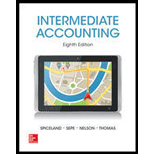
Concept explainers
1.
Depreciation:
Depreciation refers to the reduction in the monetary value of a fixed asset due to its wear and tear or obsolescence. It is a method of distributing the cost of the fixed assets over its estimated useful life. The following is the formula to calculate the depreciation.
To Calculate: The depreciation amount for the year 2016, and 2017 using straight-line method.
1.
Explanation of Solution
Calculate depreciation using Straight-Line Method:
Straight-line method:
Under the straight-line method of depreciation, the same amount of depreciation is allocated every year over the estimated useful life of an asset.
Calculate the depreciation expense for the year 2016.
Calculate the depreciation expense for the year 2017.
Working Note:
Calculate the depreciation expense.
Thus, the depreciation expense for the year 2016, and 2017 as per
2.
To Calculate: The depreciation amount for the year 2016, and 2017 using sum-of-the years’ digits method.
2.
Explanation of Solution
Sum-of- the-years’ digits method:
Sum-of-the years’ digits method determines the depreciation expense by multiplying the
Calculate the depreciation expense using sum-of-years’ digits method.
Calculate the depreciation expense for the year 2016.
| Year |
Depreciable Base(2) ($) |
Depreciation rate per year |
Number of months the asset is in service |
Depreciation ($) |
|||
| 2016 | 110,000 |
|
|
|
|
= | 5,000 |
Table (1)
Calculate the depreciation expense for the year 2017.
| Year |
Depreciable Base(2) ($) |
Depreciation rate per year |
Number of months the asset is in service |
Depreciation ($) |
|||
| 2017 | 110,000 |
|
|
|
|
= | 15,000 |
| 110,000 |
|
|
|
|
= | 4,500 | |
| Total | 19,500 |
Table (2)
Working notes:
1. Calculate the sum of the digits
2. Calculate the value of depreciable base
Thus, the depreciation expense as per sum-of-the-years’ digits method for the year 2016 and 2017 is$5,000, and $19,500 respectively.
3.
To Calculate: The depreciation amount for the year 2016, and 2017 using double-declining balance method.
3.
Explanation of Solution
Double-declining-balance method:
It is an accelerated method of depreciation under which the depreciation declines in each successive year until the value of asset becomes zero. Under this method, the book value (original cost less
Calculate the depreciation expense using Double-declining-balance method.
Calculate the depreciation expense for the year 2016.
Working Note:
Determine the depreciation rate applied each year.
Useful life = 10 years
Note: Use 100% to represent depreciation in percentage. Multiply the depreciation rate by 2 as it is a double-declining method.
Calculate the depreciation expense for the year 2017.
Thus, the depreciation expense as per double declining balance method for the year 2016 and 2017 is$5,750, and$21,850 respectively.
4.
To Calculate: The depreciation amount for the year 2016, and 2017 using one hundred fifty percent declining balance method.
4.
Explanation of Solution
One hundred fifty declining-balance method:
It is an accelerated method of depreciation under which the depreciation declines in each successive year until the value of asset becomes zero. Under this method, the book value (original cost less accumulated depreciation) of the long-term asset is decreased by a fixed rate. It is one and half times the rate of the straight-line depreciation.
Calculate the depreciation expense using One hundred fifty declining-balance method.
Calculate the depreciation expense for the year 2016.
Calculate the depreciation expense for the year 2017.
Thus, the depreciation expense as per one hundred fifty percent declining balance method for the year 2016 and 2017 is$4,313, and $16,603respectively.
5.
To Calculate: The depreciation amount for the year 2016, and 2017 using unit-of-production method.
5.
Explanation of Solution
Unit-of-production method:
Under this method of depreciation, the depreciation expense is calculated on the basis of units produced in a year. This method is suitable when a company has fluctuating productive rate.
Calculate the depreciation expense using Unit-of-production method.
Calculate the depreciation expense for the year 2016.
Determine the depreciation expense for the year 2017.
Working Note:
Determine the depreciation per unit.
Thus, the depreciation expense as per units-of-production method for the year 2016 and 2017 is $5,000, and$12,500 respectively.
Want to see more full solutions like this?
Chapter 11 Solutions
INTERMEDIATE ACCOUNTING

 AccountingAccountingISBN:9781337272094Author:WARREN, Carl S., Reeve, James M., Duchac, Jonathan E.Publisher:Cengage Learning,
AccountingAccountingISBN:9781337272094Author:WARREN, Carl S., Reeve, James M., Duchac, Jonathan E.Publisher:Cengage Learning, Accounting Information SystemsAccountingISBN:9781337619202Author:Hall, James A.Publisher:Cengage Learning,
Accounting Information SystemsAccountingISBN:9781337619202Author:Hall, James A.Publisher:Cengage Learning, Horngren's Cost Accounting: A Managerial Emphasis...AccountingISBN:9780134475585Author:Srikant M. Datar, Madhav V. RajanPublisher:PEARSON
Horngren's Cost Accounting: A Managerial Emphasis...AccountingISBN:9780134475585Author:Srikant M. Datar, Madhav V. RajanPublisher:PEARSON Intermediate AccountingAccountingISBN:9781259722660Author:J. David Spiceland, Mark W. Nelson, Wayne M ThomasPublisher:McGraw-Hill Education
Intermediate AccountingAccountingISBN:9781259722660Author:J. David Spiceland, Mark W. Nelson, Wayne M ThomasPublisher:McGraw-Hill Education Financial and Managerial AccountingAccountingISBN:9781259726705Author:John J Wild, Ken W. Shaw, Barbara Chiappetta Fundamental Accounting PrinciplesPublisher:McGraw-Hill Education
Financial and Managerial AccountingAccountingISBN:9781259726705Author:John J Wild, Ken W. Shaw, Barbara Chiappetta Fundamental Accounting PrinciplesPublisher:McGraw-Hill Education





